Mushroom Identification Basics
Identifying mushrooms requires a cautious approach, particularly if you intend to consume them. Since the majority of mushrooms are inedible and some of the most common varieties are poisonous, misidentification can lead to serious consequences. While photographs can offer assistance, they should not be solely relied upon for identification. Mushrooms can display significant variations in appearance due to differences in growth stages, environmental factors, and even damage from animals. Even if you are familiar with a certain mushroom species, these factors can cause it to resemble other species closely. To ensure accuracy, it is essential to consult multiple sources such as field guides, online resources, and experienced mushroom enthusiasts. Never rely on a single source, and always approach identification with a healthy dose of skepticism.
In order to have the best possible starting point for identification, pick the mushroom or, more precisely, the mushroom fruiting body from the ground, being careful to get the entire fruiting body in one piece. Mushrooms are fragile, which is why you can make picking easier by using a mushroom knife or a regular knife to pry the base of the mushroom from the ground or tree. The base of the stem may contain valuable identifying characteristics that would be missed if the stem were cut. If you're not planning to try to identify the mushroom in the field, put it in a well-ventilated basket, perhaps in a corner lined with moss, and take it home intact to identify it with literature.
Step 1: Determine the Main Group
After collecting the mushroom, the identification process begins by determining which group it belongs to. First, inspect the underside of the cap. If it is covered in gills, which are narrow strips arranged radially around the stem, the mushroom belongs to the gilled mushroom group, which includes russulas, amanitas, and many others. The familiar chanterelle and funnel chanterelle have structures on their underside that resemble gills, but they are actually ridges folded in a gill-like manner.
If there are small holes on the underside, the mushroom is a "pored mushroom". If the mushroom is soft and the pore layer can be easily detached, it is a bolete. A hard, woody, or tough find, often without a stem but sometimes with one, is a polypore. If the underside is full of spines, it is a hedgehog mushroom.
Occasionally, you may encounter round, stalked or stalkless "balls" without a clear cap. These are puffball mushrooms. Their spores are produced inside the fruiting body, which ruptures as it ages, and the spores are then spread by the wind.
These are some main groups of mushrooms, and after you have determined to which group the mushroom belongs, you should continue by checking the characteristics of the mushrooms in the literature you are using.
Step 2: Observe Key Features
Cap
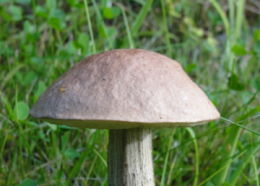
The shape can vary from bell-shaped to conical and flat to funnel-shaped. It is good to remember that the cap shape of a young mushroom is almost always domed and bell-shaped. It is useful to compare the shapes similar to the descriptions in the mushroom book to fully grown fruiting bodies.
The colour also changes according to the age of the fungus and the weather it is in. For example, the colours of the mushrooms in the Russula genus fade in the rain. Some mushroom caps clearly change with moisture, meaning they are hygrophanous. This usually means that the cap is significantly darker or a deeper color when wet and fades when dry. This fading is not due to loss of pigmentation, but rather due to the drying out of the spaces between the cells in the cap. Kuehneromyces mutabilis is a particularly good example of a hygrophanous mushroom; it is a dark honey colour when wet and the center of the cap begins to fade as it dries.
The hat skin also holds a lot of information: it can be slimy, sticky, dry, smooth, grainy, scaly, or speckled with fallen scales. Each property is helpful in the identification process.
Gills and Pores/Tubes
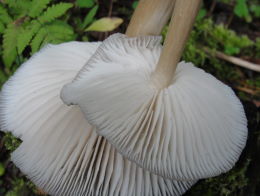
The gills and tubes vary depending on the species. Important characteristics are the width, thickness, and density of the gills, any branches present, and the way in which they are attached to the stem. The colour of the gills and tubes is also an important feature.
How a mushroom's gills are attached to the stem is important when identifying mushrooms. The following is a list of the standard types of gill attachments.
Free
Free gills are not attached to the stem, but rather are completely detached from it.
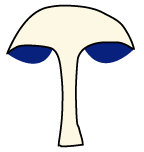
Adnate
Gills that are broadly attached to the stem are called adnate.
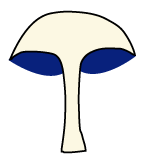
Decurrent
Gills that extend down the stem are called decurrent. The edge of a decurrent gill usually approaches the stem at a slant, so the gill gets wider as it nears the stem.
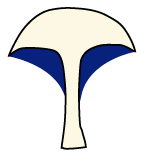
Adnexed
Adnexed gills are narrowly attached to the stem at an angle, usually between 45 and 90 degrees. They may appear almost free.
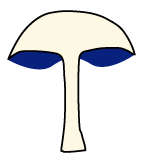
Emarginate
Emarginate gills are notched just before reaching the stem. Their height stays the same until they suddenly become shallower near the stem.
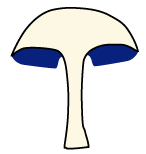
Sinuate
Sinuate gills are similar to emarginate gills, but curve slightly downward before attaching to the stem.
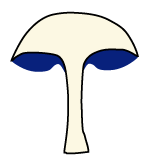
Spore Print
The colour of the spore print is a fairly consistent characteristic and therefore helps to distinguish between fungi. Identify the colour by taking a spore print: place a healthy cap, with the gills facing down, on a sheet of paper. A half white and half black paper works best to contrast all colours. After a few hours, examine the trace of spore powder. Spore prints can be white, cream, pink, brown, black, or even yellow.
Foot (Stem)
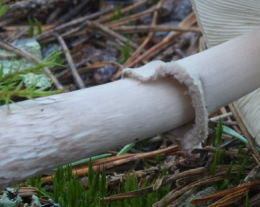
The stem can be hollow or solid, tough or fragile, slimy, sticky or dry, long or short. Look for distinctive features: a ring (annulus), a volva at the base, surface texture, or color changes.
Some mushrooms like Macrolepiota procera have a movable ring, while others like Amanita muscaria have both a ring and a bulbous base enclosed in a volva.
Flesh
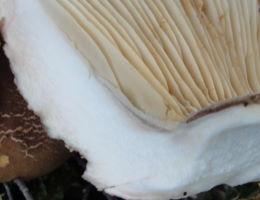
Mushroom flesh is often fibrous. In Russula and Lactarius, it is brittle and breaks easily in all directions. Some mushrooms like Lactarius deliciosus exude latex when cut, which can also change color after exposure.
Scent
Many mushrooms have a distinct scent. These can be mild or very pronounced and are often compared to familiar smells such as licorice, pencil, flour, or fish. For example, Lepista nuda (Wood Blewit) is known for its fruity, rubbery aroma.
Habitat
The environment gives many clues. Some mushrooms grow only with certain trees. For example, Leccinum scabrum grows with birch, while others like Boletus edulis prefer spruce or pine. Also note if the mushroom grows from wood, soil, or moss. Some are mycorrhizal, others saprophytic.
Step 3: When in Doubt
If all this sounds complicated, you can ask for help with your identifications on mushroom identification groups on Facebook, like the public Mushroom Identification group. There are also AI-powered apps for mushroom identification, but they often make mistakes.
It's also important to know that many mushrooms take years of experience to identify reliably.
Although efforts have been made to ensure accuracy on this website, the information may contain errors and omissions. Therefore, all content provided is for educational and informational purposes only and should not be relied upon or used as a basis for consuming any plants or mushrooms.